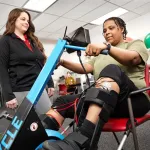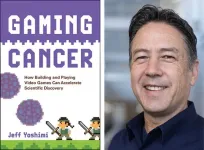(Press-News.org)
While entangled photons hold incredible promise for quantum computing and communications, they have a major inherent disadvantage. After one use, they simply disappear.
In a new study, Northwestern University physicists propose a new strategy to maintain communications in a constantly changing, unpredictable quantum network. By rebuilding these disappearing connections, the researchers found the network eventually settles into a stable — albeit different — state.
The key resides in adding a sufficient number of connections to ensure the network continues to function, the researchers found. Adding too many connections comes with a high cost, overburdening the resources. But adding too few connections results in a fragmented network that cannot satisfy the user demand.
The findings potentially could lead to optimally designed quantum networks for lightning-fast computing and ultra-secure communications.
The study was published today (Jan. 23) in the journal Physical Review Letters.
“Many researchers are putting significant efforts into building larger and better quantum communication networks around the globe,” said Northwestern’s István Kovács, the study’s senior author. “But, as soon as a quantum network is opened up to users, it burns down. It’s like crossing a bridge and then burning it down behind you. Without intervention, the network quickly dismantles. To tackle this problem, we developed a simple model of users. After each communication event, we added a fixed number of bridges, or links, between disconnected nodes. By adding a large enough number of links after each communication event, we maintained network connectivity.”
An expert in complex systems, Kovács is an assistant professor of physics and astronomy at Northwestern’s Weinberg College of Arts and Sciences.
Network of disappearing links
Quantum networks work by harnessing quantum entanglement, a phenomenon in which two particles are linked, regardless of the distance between them. Xiangi Meng, an expert in quantum communication and one of the study’s first authors, describes entanglement as a “spooky” but effective resource. At the time of the research, Meng was a research associate in the Kovács group but now is an assistant professor of physics at Rensselaer Polytechnic Institute in New York.
“Quantum entanglement is the spooky, space-time-defying correlation between quantum particles,” Meng said. “It’s a resource that allows quantum particles to talk to each other, so they can perform complex tasks together while ensuring no eavesdropper can intercept their messages.”
When two computers communicate using entangled links, however, the links involved in that communication disappear. The act of communication itself alters the quantum state of the link, making it unusable for further communications.
“In classical communications, the infrastructure has enough capacity to handle many, many messages,” Kovács said. “In a quantum network, each link can only send a single piece of information. Then it falls apart.”
Pinpointing the magic number
To better understand how networks behave under constant change, Kovács and his team built a simplified model of users within a quantum network. First, the researchers enabled users to randomly select other users with whom to communicate. Then, they found the shortest, most efficient communication path between those users and removed all the links along that path. This created a “path percolation,” where the network gradually breaks down with each communication event.
After exploring this problem, Kovács and his team sought to offer a solution. Through modeling, they found the exact number of links to add after each communication event. That number resides at the critical boundary between maintaining the network and fracturing the network. Surprisingly, the team found the critical number is just the square root of the number of users. If there are 1 million users, for example, then 1,000 links need to be re-added for every 1 qubit of information sent through the network.
“It would be natural to expect that this number increases linearly with the number of users, or maybe even quadratically, as the number of user pairs that could communicate,” Kovács said. “We found the critical number actually is a very small fraction compared to the number of users. But, if you add fewer than that, the network will fall apart, and people cannot communicate.”
Kovács envisions this information potentially could help others design an optimized, robust quantum network that can tolerate failures. New links could be automatically added when other links disappear — creating a more resilient network.
“The classical internet was not built to be fully robust,” Kovács said. “It naturally emerged due to technological constraints and user behavior. It was not designed, it just happened. But now we can do better with the quantum internet. We can design it to ensure it reaches its full potential.”
The study, “Path percolation in quantum communication networks,” was supported by the National Science Foundation (grant number PHY-2310706).
END
Major uncertainties remain about the impact of puberty blockers and gender affirming hormone therapy on children and young people with gender related distress (gender dysphoria), making it impossible to determine conclusively whether they help or harm, find two pooled data analyses of the available evidence, published online in the Archives of Disease in Childhood.
The findings echo those of the Hilary Cass review of gender identity services in the NHS, published last April. This concluded that the evidence for the use of puberty blockers and masculinising and feminising hormones for gender related distress—psychological distress caused by a mismatch between birth sex and gender ...
The prevalence of psychological distress caused by a mismatch between birth sex and gender identity, formally known as gender dysphoria, likely rose 50-fold nationwide between 2011 and 2021, suggests an analysis of primary care data in England and published online in Archives of Disease in Childhood.
This means the condition is still uncommon, with fewer than 1 in 200 17-18 year olds affected, but levels of concurrent anxiety, depression, and self harm are high. And access to timely care is a live issue for young people and their families, a second feedback study shows.
Most previously ...
Over the course of two decades, the lifespan of college graduates increased by 2.5 years to 84.2 years. If they were a country, their life expectancy would have ranked fourth globally.
By contrast, the lifespan of those who didn’t earn a high school diploma remained at 73.5 years. If they were a country, their life expectancy would have ranked 137th globally.
SEATTLE, Wash., Jan. 23, 2025 – Across more than 3,000 US counties, vast geographic differences with a widening gap were registered between the least and most educated, with a longer lifespan for those with a higher level of education. That’s ...
While climate change is likely to present significant challenges to agriculture in coming decades, it could also mean that crops such as chickpeas, soyabeans and oranges are widely grown across the UK, and home-produced hummus, tofu and marmalade are a common sight on our supermarket shelves by 2080.
A new study led by the UK Centre for Ecology & Hydrology (UKCEH) in collaboration with the University of East Anglia (UEA) predicts that future warmer temperatures in this country would be suitable for a variety ...
Researchers from The Ohio State University Wexner Medical Center and College of Medicine’s School of Health and Rehabilitation Sciences (HRS) recently published a study that found a link between impairments in physical function and hospital readmission risk among adults 50 years of age and older.
According to the Agency for Healthcare Research and Quality, 17% of Medicare beneficiaries in the United States returned to the hospital within 30 days of discharge between 2016 and 2020, posing burdens on healthcare systems and patients, alike.
“Physical function is a crucial indicator of underlying ...
DALLAS, January 23, 2025 — The American Heart Association, a global force changing the future of health for all, is championing student health and well-being by awarding financial grants to seven schools nationwide. These grants, provided through the Association’s Kids Heart Challenge™ and American Heart Challenge™ programs, enable schools to invest in resources like fitness equipment, water bottle filling stations, and educational tools to support healthier environments. By directly funding these in-school resources, the Association aims to foster healthy habits in youth to combat issues like childhood obesity—which, according to ...
A team of researchers from NYU Tandon’s C2SMARTER — a U.S. Department of Transportation-funded Tier 1 University Transportation Center — has received an NVIDIA Academic Grant Program award to develop an advanced simulation system aimed at improving emergency response in urban areas.
The project, called NanoDT (Nano Digital Twin), will create a detailed virtual replica (or “digital twin”) of Downtown Brooklyn that can help emergency responders better navigate accident scenes and ...
HOUSTON, January 22, 2025 — Marcus Freeman, head coach at the University of Notre Dame, was named college football Coach of the Year at the American Heart Association’s Paul “Bear” Bryant Awards, presented by Marathon Oil. The 39th annual awards program benefits the American Heart Association, the world’s leading voluntary health organization devoted to a world of longer, healthier lives for all.
“We are honored to award Coach Freeman this year’s Paul “Bear” Bryant Coach of the Year Award, recognizing his exemplary efforts ...
Cancer is vicious. In 2025, it is expected to cause more than 618,000 U.S. deaths — nearly twice the combined populations of Merced and Modesto. Each year, almost half of this nation, young and old, is touched by the disease through personal diagnosis or an afflicted loved one.
Jeff Yoshimi joined the 50% when his wife, Sandy, learned she had breast cancer. The blighted cells had spread to some lymph nodes.
Alongside Sandy during one of many overnight hospital stays, Yoshimi drifted in and out of sleep, sifting through ideas ...
“Fight-or-flight” is not an option for plants, unfortunately, when it comes to pathogen attacks. Instead, plants opt for “do-or-die.” A deeper insight into the genetic mechanisms that enable plants to resist pathogen infections has equipped researchers with tools to tackle the most devastating pathogens in agriculture. Using advanced RNA sequencing, researchers have recently uncovered how varieties of soybean respond to different types of soybean cyst nematodes (SCNs), with potential implications for developing more resilient crops and reducing reliance on chemical treatments.
Published ...


